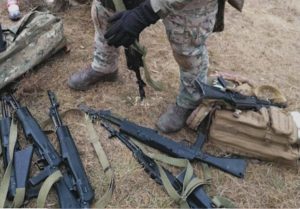After the collapse of the Soviet Union, Ukraine got a large fleet of BTR-60 armored personnel carriers, which by that time were considered obsolete. Most of these vehicles were withdrawn from the armed forces’ service and remained in use only as specialized vehicles and in units of the Interior Ministry.
Over the years of independence, the Ukrainian government sold about 40 vehicles abroad, and some more were demilitarized and sold on the civilian market as high-mobility vehicles. Nevertheless, as of 2011, up to a thousand APCs of different versions remained in storage.
Probably, their fate could have ended as scrap metal in numerous depots of Armored and Repair Enterprises, but with the outbreak of the Russian-Ukrainian war in 2014, they again became in demand.
It is known that a certain number of these armored personnel carriers were used in combat during the Battle of Ilovaisk, primarily by the fighters of the National Guard, including the battalion ’Donbas’.
Since October 2014, BTR-60PB has been restored and transferred to the military in small batches. The main users of these vehicles were the newly created motorized infantry brigades. In addition, in marine units, these armored personnel carriers remained the main combat unit until 2020.

However, this process was more of a single case due to the presence of more modern armored personnel carriers like the BTR-70 and BTR-80.
The Soviet-era BТР-60 armored personnel carrier found new life after the start of the full-scale Russian invasion to Ukraine in 2022, when the Ukrainian army began to build up its personnel, for which a large volume of armored vehicles was needed to repel the enemy.
BTR-60PB
BTR-60PB vehicles, as well as special vehicles built on their chassis, in fact, remain the only armored personnel carriers of this family in storage in Ukraine.
It is an upgraded version of the BTR-60PA, developed in 1964 and mass-produced from 1965 to 1976. The main innovation of this version was the appearance of a new turret with a KPVT 14.5mm heavy machine gun, and a twin PKT 7.62 mm machine gun.
The vehicle is capable of carrying up to eight soldiers, in addition to a crew consisting of three people: a driver, a gunner, and a vehicle commander.
One of the most serious disadvantages of the BTR-60PB is the archaic design of its propulsion system. The armored personnel carrier is equipped with two engines with separate transmissions, which greatly complicates its maintenance and repair. The operational reliability of such a system turned out to be low. In addition, two twin GAZ-40P 90-horsepower gasoline engines for a ten-ton vehicle turned out to be weak.
The vehicle stands out for its weak armor protection, capable of withstanding only light rifle weapons. Moreover, even such meager protection is not guaranteed when shooting into the side projection from close distances.
Another BTR-60PB problem is its layout with the placement of the squad compartment in the central part and the transmission compartment in the aft part. Such a design prevented the infantry deployment from the rear of the vehicle and forced it to be made on the sides.

The hatches for infantry exit on an armored personnel carrier are too narrow and placed more than one meter above the ground, which is extremely inconvenient and traumatic for soldiers. Transportation of wounded because of this is generally impossible.
Ways of modernization
Currently, most of the BTR-60s in Ukraine are in depots and on the training grounds of armored enterprises where it is actually rusting under the open air. Therefore, in addition to making improvements to the design, this equipment also requires major repairs with the replacement of most units.

The main areas of modernization should be solving problems with mobility, increasing security, and optimizing the layout of the landing compartment.
The ‘Khorunzhiy’
BTR-60 Khorunzhiy is a deep modernization of the Soviet BTR-60 developed by the Ukrainian company Praktika in 2021.
The armored personnel carrier has undergone a new compartmental layout, with the engine compartment in the front right section, the driver’s compartment in the front left section, and a more spacious infantry compartment in the rear part of the hull with a ramp.
The Khorunzhiy armored hull has a higher level of armor protection, which protects the upper and side parts of the hull at the PZSA-4 level (protection from firing with SVD and AKM bullets 7.62mm from 10 meters). In addition, the vehicle implements mine protection by installing a multi-layer floor and special shock-mitigating suspension seats.
The vehicle has been equipped with a modern Deutz diesel engine and a new Allison automatic transmission, allowing for proper mobility. The driver has also been provided with cameras around the vehicle to enhance situational awareness.

Such modernization is the most comprehensive and solves all the problems of the original vehicle. However, the complete replacement of the armored hull and the engine transmission compartment is an expensive and complex solution, which is not advisable in a war.
BTR-60PB-MD1
An alternative solution could be the refurbishment of armored personnel carriers following the example of the Bulgarian modernization of the BTR-60PB-MD1 carried out in the early 2000s.
The main difference between this project is the preservation of the original armored hull and the combat compartment with a closed turret. To simplify access to the squad compartment, a door was cut between the second and third axles on the sides of the vehicle.
During the conversion of the BTR-60PB, two GAZ-40P engines were replaced with one Cummins ISB 25.30 six-cylinder diesel engine with a capacity of 250 hp with an Allison automatic transmission. For their installation, the volume of the aft part was expanded by adding armored panels.

It is known that Ukrainian engineers are currently working in a similar direction, conducting comprehensive repairs and upgrades. However, the exact scope of these works is unknown.
In the frames, you can see that the vehicles come from depots in the form of hulls and chassis lacking salvageable components for restoration.
Judging by the frames, new vehicles receive a set of slat armor, which should increase the protection of the vehicle to a level that will ensure reliable exposure to fire from small arms. Full-fledged doors are also installed on the sides.
Seats in the squad compartment are fixed to the ceiling to preserve the health of the crew in case of an explosion in the mine.

An open turret for a heavy machine gun is installed on the roof of the turret. Indirectly, this may speak of the conversion of non-combat vehicles 1V18 Klen artillery reconnaissance vehicles and its derivatives.
According to the author of the photo, the vehicles are being re-motorized with the installation of a diesel engine from the American HMMWV army SUV. The power of such engines is comparable to the two original GAZ-40P. Presumably, the gearbox was also replaced.
Does the Ukrainian Army need BTR-60s?
In addition to the considerable number of “rotten hulls” already in possession by the Ministry of Defense, Ukraine is also acquiring vehicles from this family from former socialist bloc countries. There have been indications in recent months, when Ukraine turned out to be in a suspended state, of the potential receipt of hundreds of BTR-60PBs from Bulgaria.
The restoration of old armored personnel carriers is currently relevant in the context of a significant shortage of armored vehicles in the troops, as well as the lack of sources for their rapid replenishment.
Relatively cheap modernization and overhaul can provide several brigades with “armored taxis” to deliver soldiers to the front line, as well as work in low-intensity combat zones, in particular, on the northern borders of Ukraine.
Given the large volume of work and the limited budget, future modernization should provide for the introduction of only the most necessary changes, such as the integration of the new engine-transmission compartment and the installation of additional armor. Work on replacing the armored hull and installing remote weapon stations can significantly increase the cost of a single unit and make the project unaffordable.
SUPPORT MILITARNYI
Even a single donation or a $1 subscription will help us contnue working and developing. Fund independent military media and have access to credible information.


 Urich
Urich 
 Андрій Харук
Андрій Харук 
 Контужений Безпілотник
Контужений Безпілотник 

 Центр ініціатив ПЖ
Центр ініціатив ПЖ 



 Vadim Kushnikov
Vadim Kushnikov 
 Андрій Тарасенко
Андрій Тарасенко 
 Юрій Юзич
Юрій Юзич 
 Віктор Шолудько
Віктор Шолудько 
 Роман Приходько
Роман Приходько 



